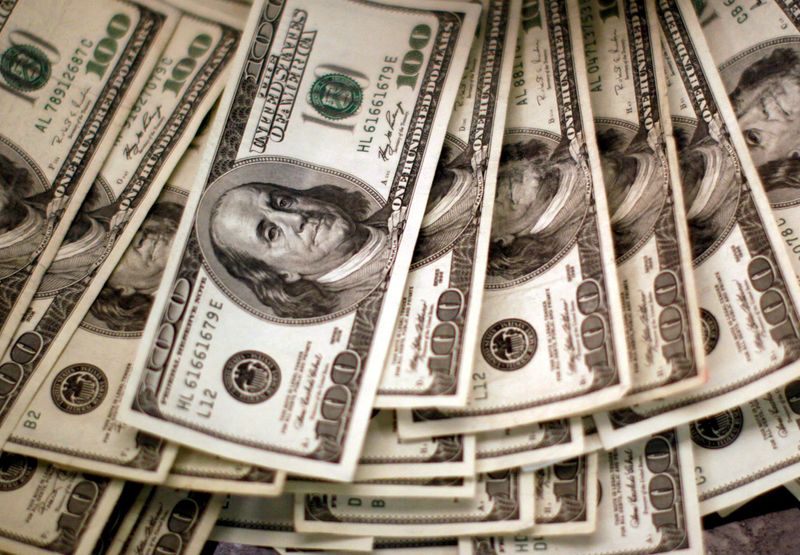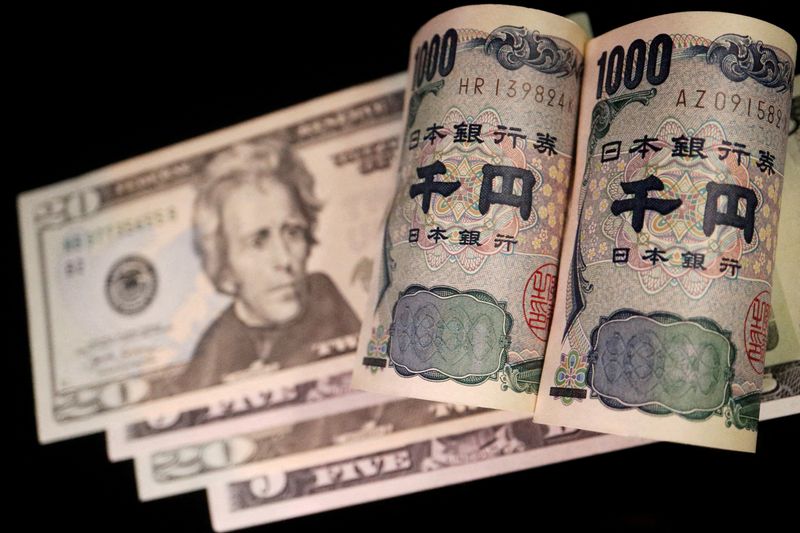By Saqib Iqbal Ahmed
NEW YORK (Reuters) -The U.S. dollar fell against a basket of currencies on Monday, tracking a retreat in U.S. Treasury yields from the 5% level hit earlier in the session, and as traders awaited fresh U.S. economic data due later this week.
The yield on the benchmark 10-year U.S. Treasury note declined on Monday after briefly rising above 5.0%, hitting the July 2007 milestone that it briefly attempted to scale last week and further threatening an economic slowdown on higher borrowing costs.
Traders are on watch for several events this week, including a European Central Bank meeting, and the release of U.S. GDP data and the Federal Reserve's preferred inflation gauge.
"A big week of data with eyes on U.S. GDP on Thursday, plus BoC (Bank of Canada) and ECB (European Central Bank) in the mix, and of course geopolitical risk remaining incredibly elevated is really denting traders' desire to do much as the week gets underway," said Michael Brown, market analyst at Trader X in London.
But the main news on Monday was the yield on 10-year U.S. Treasuries reaching as high as 5.021%, the latest stage of a relentless sell-off in government bond markets, driven by investors accepting central banks will keep rates persistently high, particularly in the United States, an increase in supply of bonds and widening term premia.
The 10-year yield was last at 4.8375%.
Besides that, the risk of Israel's war with the Islamist group Hamas becoming a wider regional conflict is keeping markets on edge, as Israeli air strikes battered Gaza early on Monday, and the United States dispatched more military assets to the region.
The dollar index, which measures the currency's strength against a basket of six rivals, was 0.6% lower at 105.56. The index had risen as high as 106.33 earlier in the session.
The surge in U.S. Treasury yields since mid-July has boosted the U.S. dollar's appeal relative to other currencies and helped lift the U.S. dollar index more than 6%, but the index has made little headway since early October.
"It's definitely interesting and surprising that neither the sell-off in long bonds nor the Middle East situation and subsequent haven demand have managed to spark much demand," Trader X's Brown said.
"I remain bullish, however, with the core U.S. economic outperformance theme continuing to ring true against G10 peers, as this week's GDP figures should prove," he said.
Barclays (LON:BARC) analysts were less sure the dollar had much further to go, however, pointing to stretched long dollar positioning and a smaller likelihood of further rises in long-dated yields without a reassessment of the Fed's rate outlook.
The Japanese yen last traded at 149.625 per dollar, after slipping as low as 150.14, a level last seen on Oct. 3.
Masafumi Yamamoto, chief currency strategist at Mizuho Securities in Tokyo, said it seemed like a set of investors were betting the BOJ would defend the 150 level, even as others saw rising U.S. yields as a reason to keep pushing the dollar up.
The ECB meets on Thursday, and a poll by Reuters shows while it is done raising rates it won't begin easing until at least July 2024. It raised its key interest rates by 25 basis points in September.
The euro was up 0.73% on the day.
The Canadian dollar rose 0.3% against the greenback on Monday, ahead of Wednesday's Bank of Canada interest rate announcement.

The central bank is probably done raising interest rates and will hold them at 5.00% for at least six months, according to a Reuters poll of economists that found a majority expecting a reduction in the second quarter of 2024 as the economy slows.
In cryptocurrencies, bitcoin was up 2.9% on the day at $30,859, a fresh 3-month high, amid investor enthusiasm about the possibility of a spot bitcoin exchange-traded fund.
